A build-up of grease, grime, and rust will not only affect the taste of your food but will also cause your electric grill to break down quickly. It can also lead to an electrical disaster! Following proper maintenance routines are important to ensure a clean electric grill is ready for your next cooking adventure. Whether you are cleaning an indoor or outdoor electric grill, we will share how to clean an electric grill properly.
What You'll Need To Clean Electric Grills
Paper Towels: Wet paper towels can be used right after cooking to wipe fresh grease from the grill surface.
Soapy Water: You'll need plenty of warm water mixed with soapy to remove the grease!
Vinegar Solution: Creating a vinegar solution is a natural and effective way to clean an electric grill, particularly for removing stubborn grease, residue, and buildup. Vinegar's acidic nature assists in breaking down stubborn grease and grime, rendering it a valuable cleaning agent.
Baking Soda Mixture: Creating a baking soda mixture is another effective and natural method to clean an electric grill, especially for removing grease and grime.
Stainless Steel Cleaner (Optional): For electric grills with a stainless steel exterior, employing a stainless steel cleaner can effectively restore its original luster, giving it a renewed and polished appearance.
Grill Brush + Scraper: You should already have a sturdy grill brush and scraper duo if you regularly use a grill to cook. A sturdy, stainless steel grill brush is very effective at scraping stubborn food particles from the grill grates. Steel wool also works well for this purpose.
Soft Brush + Sponge: You'll also need a soft brush or non-abrasive sponge at the other end of the spectrum. Some parts of an electric grill are more delicate, such as the heating element and cooking grates made from ceramic and porcelain. The softer scrub brush and sponge will let you work on the areas the metal grill brush would ruin.
Cloth Towels: Once you've finished cleaning, you'll need to wipe everything down with a dry cloth. Microfiber is a great material for this because it doesn't deposit lint and delivers a streak-free shine.
Spray Bottle: You will need a spray bottle to hold your cleaner.
How To Clean An Electric Grill
Unplug The Grill
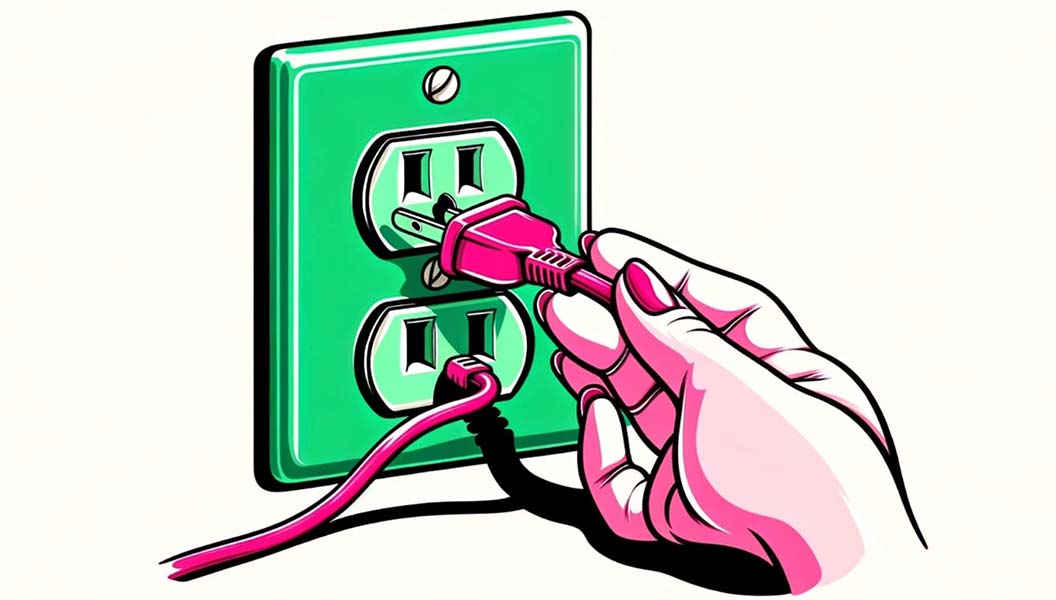
Electric grills and water are not compatible. Starting to clean an electric grill without ensuring it is turned off and unplugged is a recipe for disaster. Not only could you receive an electric shock, but your power supply could short circuit, and the grill would be ruined.
Remove The Removable Grill Plates
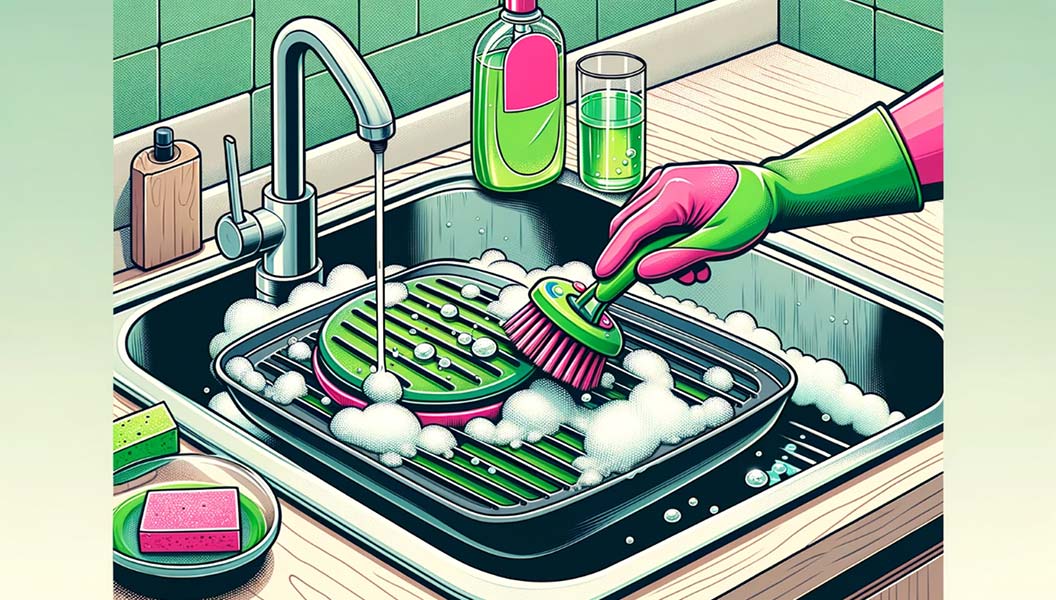
While you can certainly wipe down the grilling grates while they are attached to the electric grill, it's easier to clean the grill deeply and thoroughly with them removed (if they're removable). Be careful when handling the removable plates immediately after using them. It's easier to remove grease build-up when the grill plates are warm with damp paper towels, but you can certainly wait for them to cool down.
Heating Elements
The best way to clean an electric grill is to let it completely cool down first to avoid any electric shock or burn risk. Use a soft or grill brush to gently remove any loose debris from the heating element, such as leftover food particles or grease.
Taking this preliminary action will simplify the subsequent cleaning process. Moisten a cloth or sponge with water and a small quantity of mild dish soap. Wring out excess water to avoid dripping. Gently wipe down the heating element to remove grease and grime buildup.
You can use a toothbrush, or soft brush dipped in soapy water to scrub the area gently for stubborn spots or hardened residue. Exercise caution to avoid exerting excessive force or causing scratches on the surface of the heating element. After wiping and spot cleaning, rinse the heating element with a damp cloth or sponge soaked in clean water. This step ensures the elimination of any lingering soap residue.
Utilize a dry, clean cloth or a paper towel to wipe the heating element, ensuring its thorough dryness before reconnecting the electric grill to the power source. Moisture could cause electrical issues if not dried properly.
Tips
- It's important to note that electric components should never be immersed in water. You also should take care to wring out the paper towels and cloth before you use them so there isn't excessive water being used.
Grill Plates
Whether your electric grill model uses grill grates or grill plates, the cleaning process is the same. They are much easier to clean immediately after use before the grease and food residue can solidify and oxidize.
Lift off the cooking grates and employ a grill brush and a scraper to eliminate sizable debris. Afterward, place the grates in a spacious basin or sink filled with warm, soapy water. Let them soak for a minimum of 15 minutes. Subsequently, use a sponge to scrub the grates until they're cleaned meticulously. Conclude by rinsing them with fresh water and then drying them using a towel.
If your electric grill's plates are non-stick, this feature makes cleaning the electric grill much easier. But it's important to use gentle methods to avoid damaging the coating. To clean an electric grill with a non-stick surface, use a soft brush or cloth to gently remove any loose food particles or residue from the grill plates. This step enhances the efficiency of the cleaning process.
When facing persistent stains or accumulations of grease, you have options for crafting effective cleaning solutions. For one, a mild mixture can be created by combining equal water and white vinegar. Additionally, a soapy solution can be concocted by blending warm water with a small quantity of mild dish soap in a basin or bucket. Afterward, dip a cloth or sponge into the chosen solution, wring out excess liquid, and softly cleanse the areas in need. The vinegar's properties come into play to effectively break down grease and grime.
Tips
- Avoid using abrasive substances, potent chemicals, or rough cleaning pads, as these can potentially harm the grill's surfaces.
- If the non-stick coating shows deterioration, consider replacing the grill plates. This approach guarantees both safe and efficient cooking.
Drip Tray
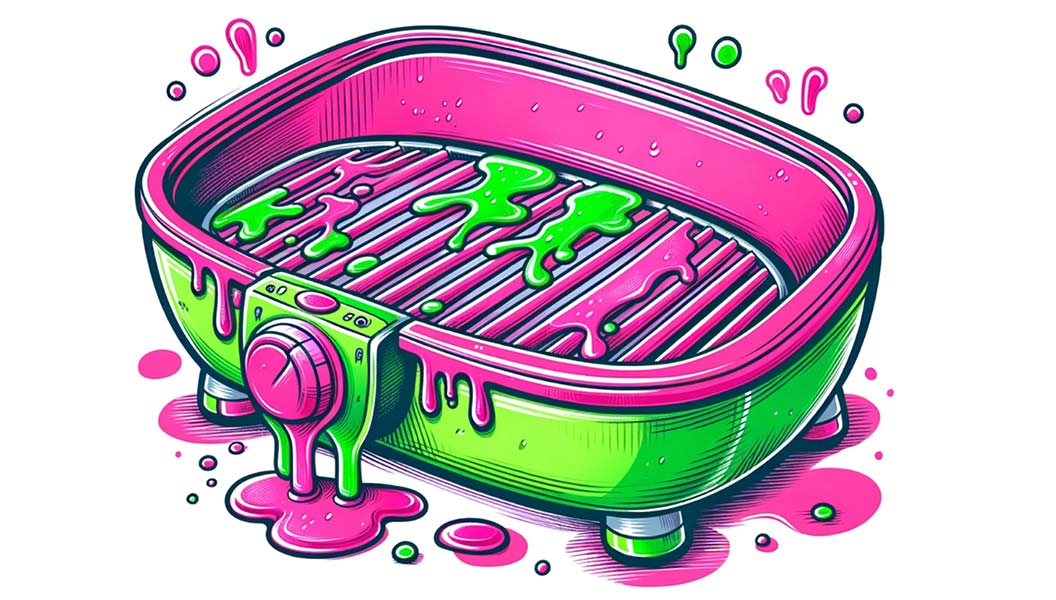
The drip tray, located under the grilling grates, catches fat that drips through. Some electric grill models have a removable drip tray, while others permanently attach it to the grill.
If the drip tray can be detached, immerse it in warm, soapy water and use a non-abrasive sponge to scrub it clean. Otherwise, allow the drip tray to cool, and then use a wet sponge to clean the attached tray. Rinse in clean water and dry with a towel or paper towel.
A solution can be concocted for particularly stubborn grease or residue by blending equal amounts of water and white vinegar. Dip a cloth or sponge into the solution and utilize it to scrub the impacted areas gently. If you have stubborn stains that don't budge with regular cleaning, mix up a paste of water and baking soda. Spread this paste onto the stains, allowing it to sit for a minimum of 10 minutes before scrubbing and rinse.
Tips:
- Consider lining the drip tray with aluminum foil to prevent grease from solidifying. This can make disposal easier and reduce the need for intense cleaning.
- If the drip tray is dishwasher-safe, you can put it in the dishwasher for cleaning. However, check the manufacturer's guidelines before doing so.
Splash Guard + Lid
These detachable parts are frequently dishwasher-safe, although you should confirm this in your owner's manual. Alternatively, clean them in the sink using warm, soapy water and a gentle sponge. Rinse with clean water and dry with a towel or paper towel.
When faced with more challenging grease or residue, you can craft a solution by combining equal amounts of water and white vinegar. Moisten a cloth or sponge with the solution and use it to scrub the areas requiring attention. Rinse the splash guard and lid under running water to remove soap or vinegar residue. Make sure to rinse all surfaces thoroughly.
Tips
- If the splash guard and lid are not removable, you can still clean them using a cloth or sponge dampened with the soapy solution.
Clean The Frame
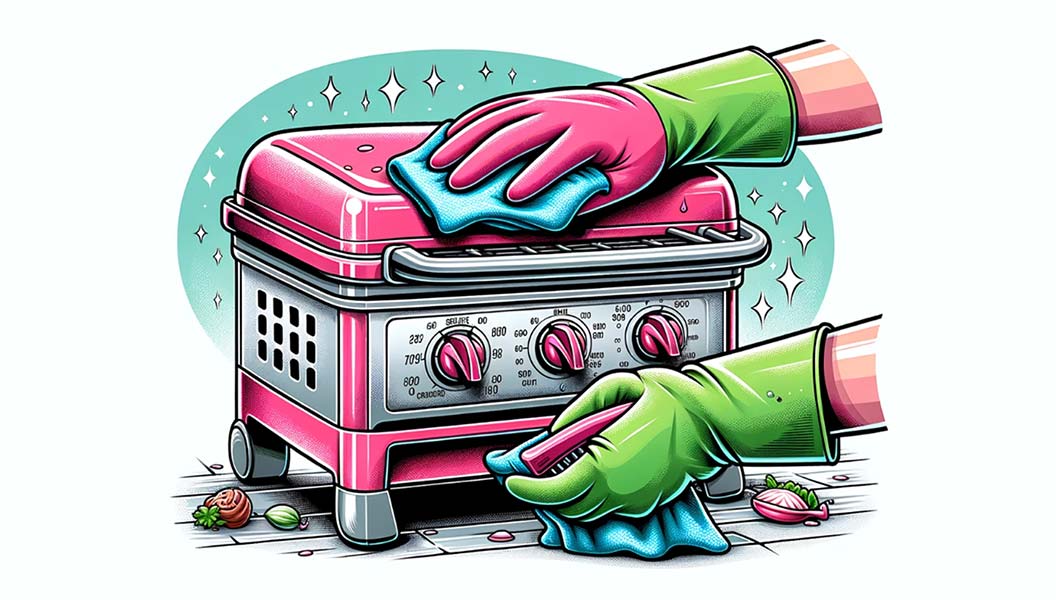
Cleaning the frame of an electric grill is important for maintaining its appearance and preventing the buildup of dirt and grease. Periodically wipe down the frame after each use to prevent excessive buildup and make cleaning sessions easier in the long run.
You can clean the legs and frame of the electric grill by using warm water and a sponge. A garden hose can be used if your electric grill is a large, outdoor model. Clean any crevices, corners, and areas that are not easily visible. These spots can accumulate dirt and grease over time.
Tips:
- Avoid using abrasive materials, strong chemicals, or abrasive cleaning pads, as they can scratch or damage the frame's finish.
Clean The Power Supply
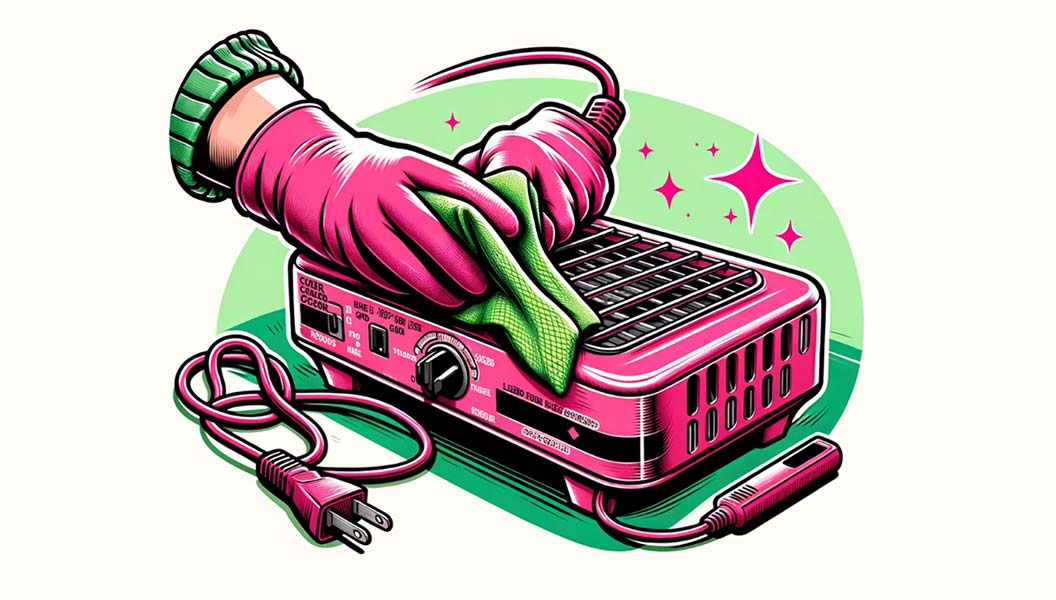
Before cleaning the power cord, make sure the electric grill is unplugged from the power source. Create a solution by combining warm water with a small quantity of mild dish soap in a bucket or basin.
Submerge a soft cloth or sponge into the soapy solution to wring out any excess water to prevent dripping. Gently wipe down the power cord using a damp cloth or sponge. Consider areas where you can see dirt, grease, or residue.
If the power cord is particularly dirty, scrub it gently with a toothbrush dipped in the soapy solution. Wipe the power cord with a damp cloth soaked in clean water to remove any soap residue. Use a clean, dry microfiber cloth or towel to wipe down the power cord, ensuring there's no moisture left on the cord.
Tips
- Avoid using abrasive materials, strong chemicals, or abrasive cleaning pads on the power cord, as they can damage the cord's insulation.
- Be gentle while cleaning the cord to prevent any strain on the wires or connectors.
